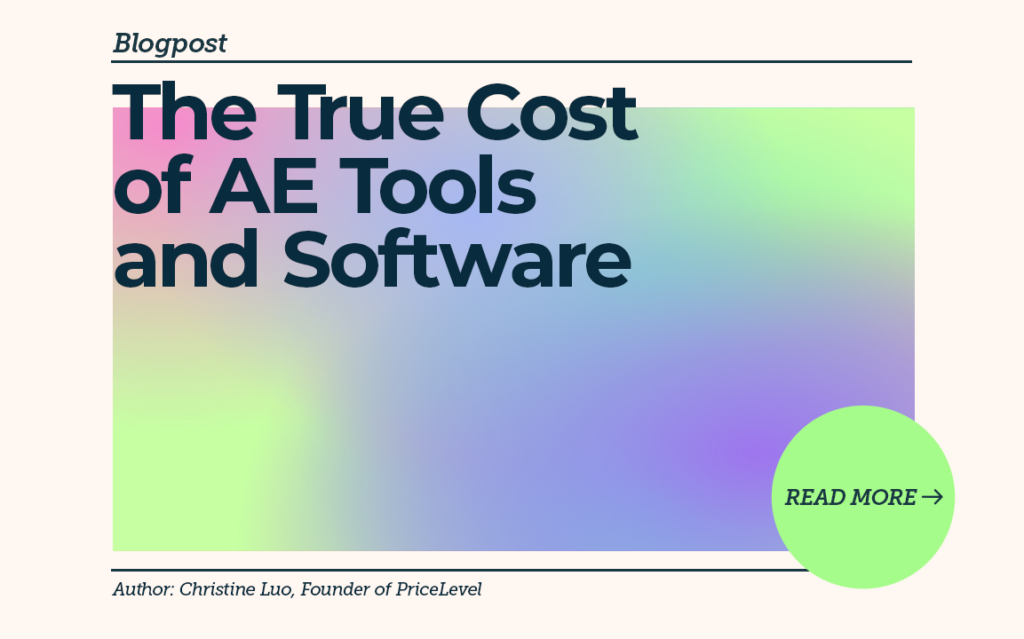Outbound Sales Strategies That Work
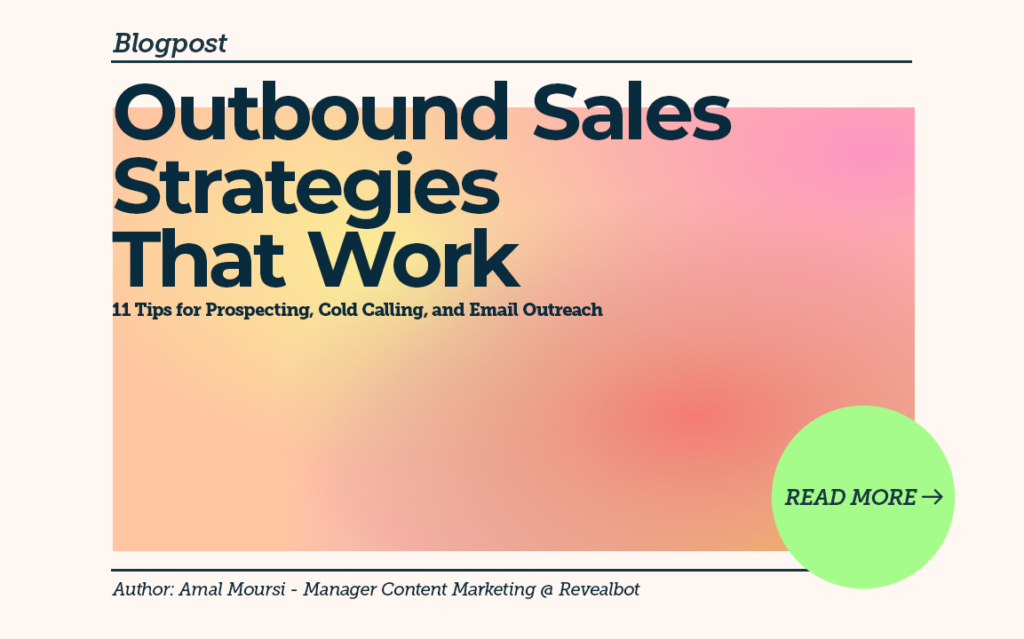
Author: Amal Moursi, content marketing enthusiast at Revealbot
11 Tips for Prospecting, Cold Calling, and Email Outreach
“Prospecting is the lifeline of sales; without it, the salesperson is out of a job.” -Zig Ziglar.
As a sales rep or business development leader, you know that consistent prospecting is pivotal to maintaining a healthy sales pipeline.
You also know that no matter how many years you’ve been in sales, you must keep up with shifting customer demands. That means continuously educating yourself on new practices so you can test and implement them.
It also means reiterating your current sales prospecting process so you can generate the most conversions as soon as possible.
This article is for you if you’re ready to add more strategies to your list or refine your current sales approach.
Keep reading to discover some of the best outbound prospecting strategies for 2024.
But first, if you’re new to prospecting or want a refresher from the good old days, here’s a quick look at outbound versus inbound prospecting:
What Is Outbound Prospecting?
Outbound prospecting is a crucial aspect of sales, where sales professionals actively reach out to potential customers who have yet to express interest in their products or services.
These prospective clients are called “cold leads” or “cold prospects.”
The key steps involved in outbound prospecting include:
- Developing customer personas to understand your target audience better.
- Generating leads through various channels, such as social media, events, and referrals.
- Engaging in direct outreach using methods such as cold emails and calls.
There are a few important roles and responsibilities involved in outbound prospecting.
For instance …
→ Sales Development Representatives (SDRs) qualify leads, conduct initial outreach, and nurture relationships with prospects.
→ Business Development Representatives (BDRs) focus on creating and expanding sales opportunities through strategic prospecting and outreach efforts.
→ Account Executives (AEs) come into the picture once leads are qualified. They work on closing deals by understanding the prospect’s needs and offering solutions that align with their goals.
It’s a collaborative effort among these roles to effectively engage with prospects, build relationships, and drive conversions.
Understanding the digital customer journey is crucial when crafting effective outbound prospecting tactics.
By mapping out common interactions prospects have with your digital channels, you can identify key opportunities to engage and nurture leads throughout their journeys.
This also helps your sales team tailor their outreach efforts to match prospects’ preferences and behaviors.
Integrating insights from the digital customer journey into outbound sales strategies allows you to optimize your outreach efforts, drive meaningful engagement, and encourage more conversions.
What’s the Difference Between Inbound and Outbound Prospecting?
Understanding the distinction between inbound and outbound strategies is key to devising a successful sales plan.
Here’s a quick look at both:
Inbound prospecting means attracting potential customers through content marketing, SEO, and social media. Leads initiate contact by showing interest in your company’s products or services.
This strategy often takes time to yield results since it relies on building brand awareness and credibility to draw in qualified leads.
On the other hand, outbound prospecting is a proactive approach where sales professionals reach out to potential customers who haven’t shown prior interest. This method includes cold calling and email outreach to initiate contact with prospects.
This strategy can yield quicker results in terms of generating leads. However, it requires a more targeted and personalized approach to resonate with your audience effectively.
What’s more effective? Inbound or Outbound Prospecting?
Both inbound and outbound prospecting have their advantages and disadvantages.
Inbound strategies are cost-effective and leverage organic interest, encouraging higher-quality leads with a genuine interest in your brand. However, they can be slower since they rely on building trust over time.
Outbound prospecting gives you more control over lead generation and can yield faster results. Although it requires more effort, you may encounter resistance from prospects not expecting the outreach.
The effectiveness of each strategy depends on your sales team’s specific goals and resources.
For instance, inbound prospecting is ideal when you’re looking to establish credibility and attract qualified leads organically.
Outbound prospecting is vital when you’re eager to conduct proactive outreach to a targeted audience and potentially close them sooner.
Combining both strategies can create a robust sales pipeline that caters to a wide range of potential customers.
The Best Outbound Prospecting Strategies for 2024
This article will focus on outbound prospecting strategies for 2024 — specifically cold calling and email outreach.
Let’s take a closer look at both options and key methods you can implement immediately and key methods you can implement immediately.
Cold Calling
“The phone is your most powerful sales tool. Embrace it.” -Wendy Weiss
How Cold Calling Works
Have you ever wondered how cold calling has remained effective, especially in an era when
Have you ever wondered how cold calling has remained effective, especially in an era when remote work is the norm?
Cold calling demands thorough research and persistence, attributes that champion sales professionals master. Despite the high attrition rate in careers relying on cold calling, success happens when you know who to call and why.
The secret sauce? Identify prospects through detailed demographic and market research — and thoroughly understand their needs.
In other words, successful sales reps don’t call random people. They call purposefully and target prospects who are aligned with their services or products which are aligned with their services or products.
They also take the time to:
- Talk through potential customers’ concerns
- Send literature, guides, and other helpful information
- Offer support with onboarding processes and more.
It’s an art and a science, combining an intuitive understanding of customer needs with hard data.
Cold calling is often misunderstood; many believe it’s outdated or ineffective.
But the evidence suggests otherwise. Cold calling has adapted, becoming a personal touch in an impersonal digital world. 88% of reps who focus on high-touch sales report that cold calling is the most effective sales tactic.
TL;DR: Cold calling isn’t about selling. It’s about connecting, understanding, and then offering a solution.
Cold Calling Tips
Without further ado, here are three strategies we recommend building into your weekly cold-calling cold-calling routine:
- Actively Work on Your Call Lists
- Schedule time daily to work through your call list — start with warm leads, then cold leads, and then lost leads.
- Prune your list when you encounter prospects who don’t align
- Use research to guide your calls and ask open-ended questions to engage prospects (see the cold calling script below)
- Always remain positive and continue to make calls, even after rejections, to maximize sales opportunities
- Focus on Prospect Quality Over Quantity
- Analyze your ideal client profile, review case studies, and identify top prospects for your products or services.
- Qualify prospects by asking about their budgets and gauging their interest in your solutions.
- Use Cold Calling Scripts
- Research tried-and-true cold-calling scripts and tailor them to your ideal customer profile
- Segment your scripts by customer group to establish a relatable context and motivate prospects to keep talking.
- Start each cold-calling script with a compelling opening line
- Improve your tonality on sales calls to sound more confident and engaging (but not pushy)
- Use value propositions to help explain “what’s it in for them.”
Here’s an example of an effective cold-calling script:
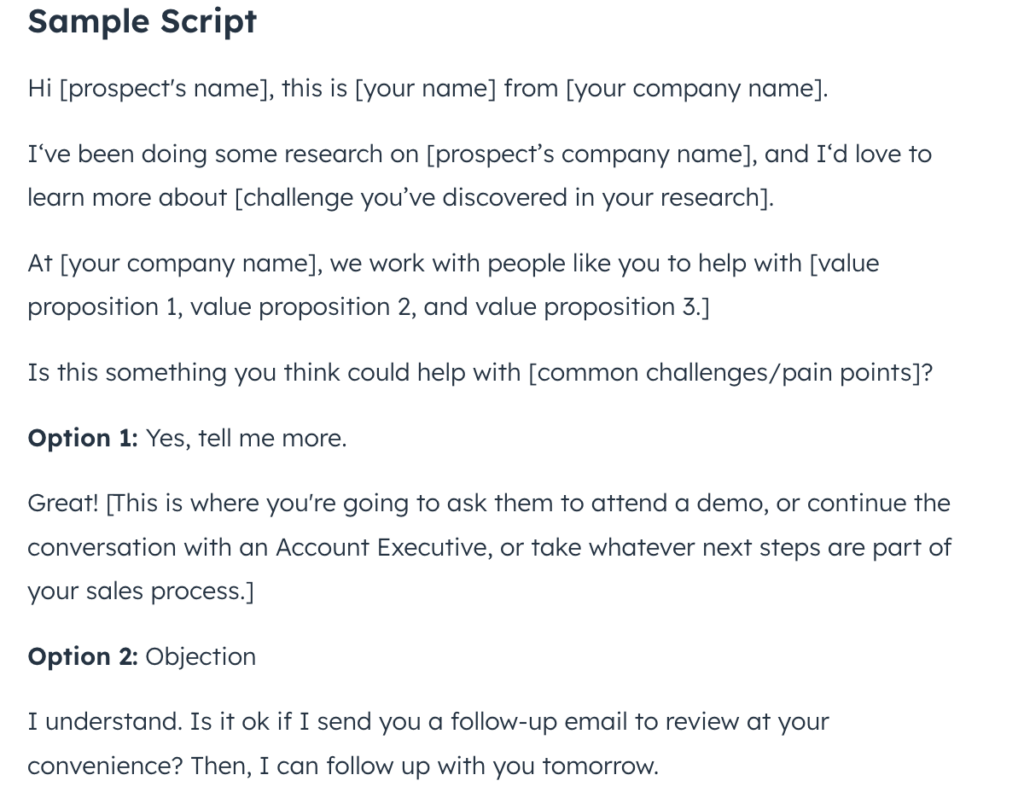
Email Outreach
“Email has an ability many channels don’t: creating valuable, personal touches—at scale.” –David Newman.
How Email Outreach Works
Email remains one of the most personalized ways to contact outbound leads.
Cold outreach email campaigns that apply segmentation and include tailored solutions help cold prospects feel seen and understood. This customized approach helps sales reps build meaningful relationships with their target audiences.
In other words, by segmenting your audience and personalizing your emails, your messages reach those most likely to find them relevant. This also makes it easier to build win-win relationships.
Effective email outreach campaigns include:
- A relevant and clear purpose for reaching out
- Thoughtful automated sequences
- An attention-grabbing subject line
- Personalized benefits language
- A clear call to action (CTA)
- Compelling body content
- Professional signatures
- Social proof
- Follow-ups
Successful email outreach campaigns also factor in email deliverability best practices.
Some examples include:
- Staying compliant with email regulations, i.e., CAN-SPAM and GDPR
- Keeping your sending reputation intact with dedicated IP addresses
- Avoiding spam trigger words in your subject lines and email body
- Personalizing the email’s “from” name
- Including a clear unsubscribe link
- Maintaining a clean mailing list
- Using a double-opt-in process
- Monitoring your sender score
Email Outreach Tips
With that foundation in mind, here are five strategies we recommend working into your weekly email outreach routine:
- Send Personalized Emails
- Capture your prospect’s attention by adding them to a segmented email list with other leads that share their characteristics and needs.
- Share tailored content across your email segments — be sure to personalize individual emails by including the prospect’s name, pain points, and your one-of-a-kind solution.
- Use behavioral triggers and AI to automate segmentation, A/B testing, and email campaign sending.
For instance, look at the following example from Form Health, a weight loss program that offers prescriptions for patients with diabetes and obesity. The brand uses guided selling sequences to send emails tailored to its customer groups automatically to send emails tailored to its customer groups automatically.
For example, the following email contains relevant and helpful content for its diabetic customer segment. Diabetic prospects in this customer group appreciate helpful literature, such as learning about Contrave vs. Mounjaro or what dietary adjustments to make.
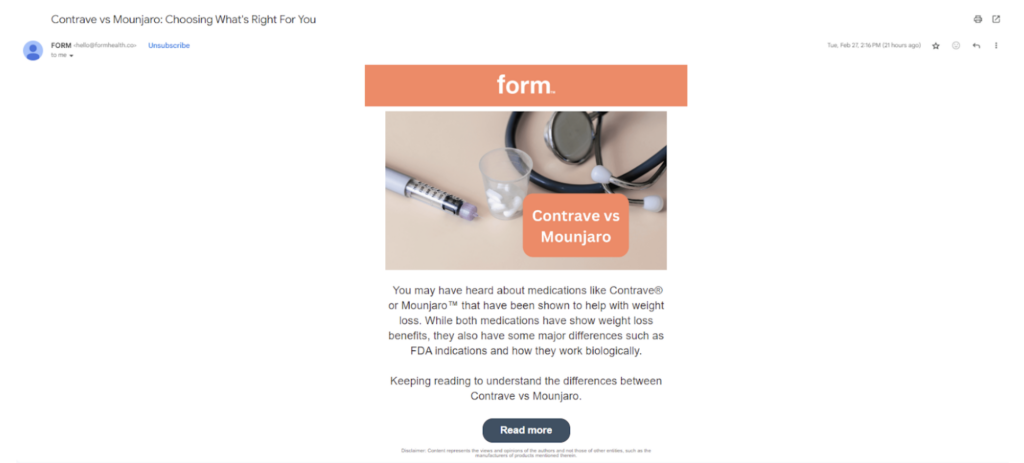
- Use a Catchy Subject Line
- Brainstorm attention-grabbing subject lines, and A/B test them to learn which leads to more open rates, clickthroughs, and conversions.
- Try subject lines with questions or statistics to grab the recipient’s attention.
- Personalize subject lines when possible by including the recipient’s name or business.
- Be original and stand out from other marketing campaigns by A/B testing creative and intriguing subject lines (i.e., “You’ll never guess what happened, Mark …”)
- Create a Compelling Offer
- Highlight compelling offers that line up with your prospect’s core needs and pain points
- Here’s how:
- Identify customer problems
- Define the dream result
- Minimize perceived risks
- Stack additional value onto the offer
- Here’s how:
- When relevant, consider creating a sense of urgency with Fear of Missing Out (FOMO) messages or deals.
- Time your offers according to special events, holidays, deals, and anniversaries
Crafting compelling offers and timing them right is a simple way to nudge aligned leads to conversion.
Take StudioSuits, renowned for its quality men’s tweed jackets. During Cyber Monday sales, it leverages email marketing to engage customers and newsletter subscribers.
Sending out limited-time discounts and exclusive offers creates a sense of urgency, prompting potential buyers to act quickly. This approach drives immediate sales and fosters long-term customer loyalty, positioning StudioSuits as a go-to destination for premium menswear.
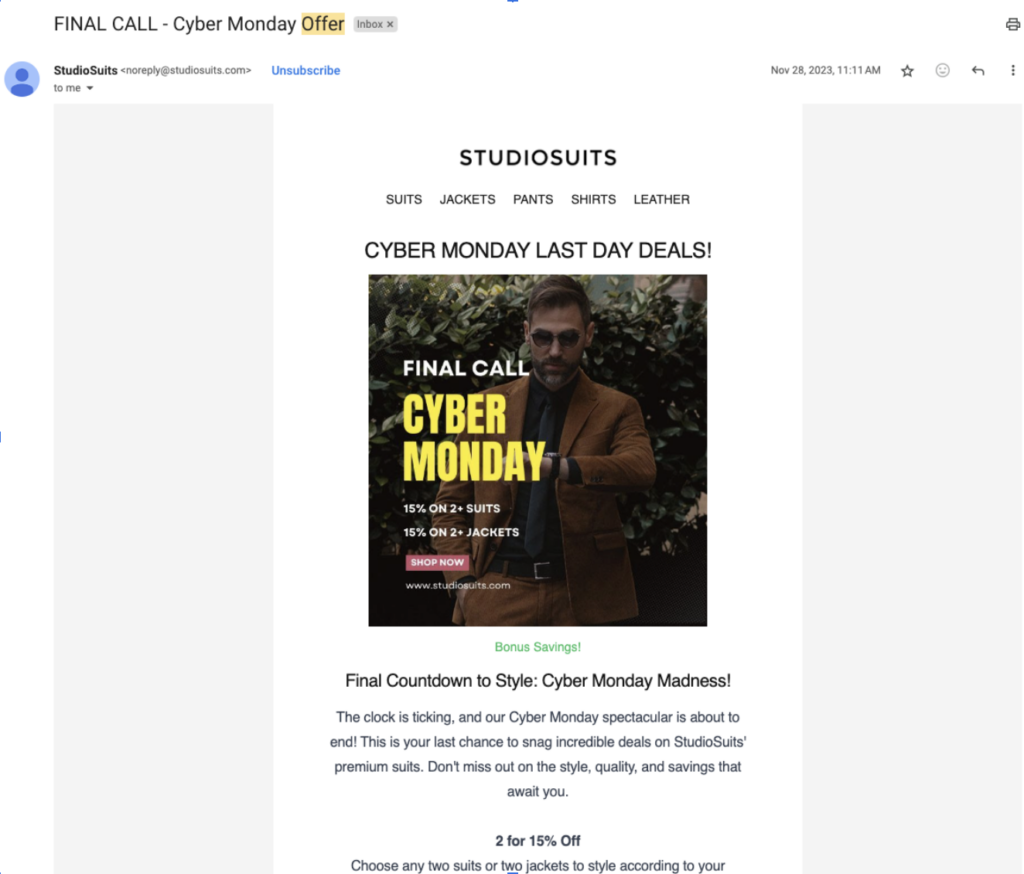
Another way to time your offer is your offer is to consider specific milestones along the customer journey.
For instance, let’s say you’re selling on behalf of a lending firm, and you’re targeting students navigating their way through higher education. These students often face the daunting challenge of managing their finances, especially when funding their education.
In this case, your compelling offer could be “no-fee” private student loans. For many new students, you could offer these during peak college scouting seasons, such as a few months before semesters begin and during the summer before the official Fall semester starts.
- Include Case Studies or Social Proof
- Build trust and remove skepticism by providing case studies and social proof in your email outreach campaigns.
- Consider creating special “before and after” campaigns that showcase the results and success of your product or service.
- Highlight core stats and other data points that reveal tangible success.
For instance, the following screenshot from Revealbot, an ads automation tool, showcases three impressive “wins” its clients have had. Interested prospects can click “Read the story” to read the official case study for each success metric.
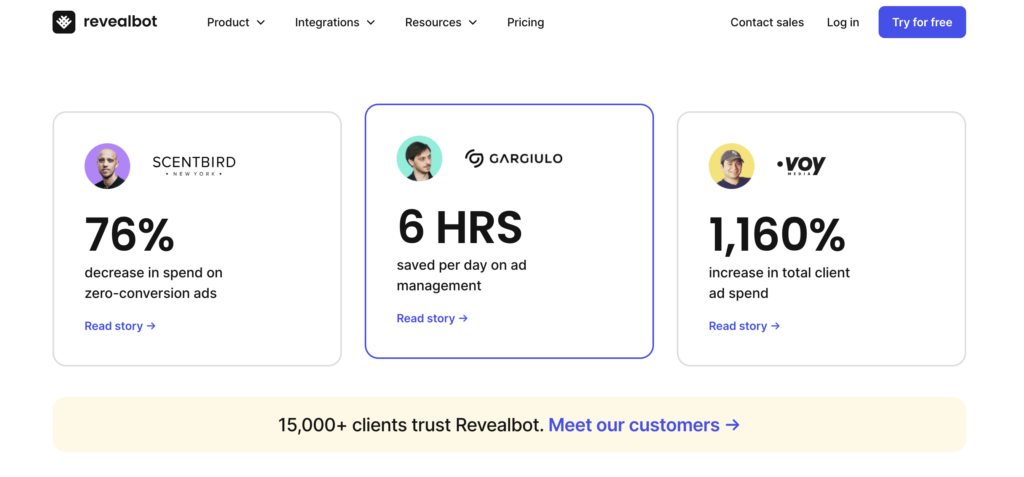
- Follow Up
- Send a sequence of follow-up emails and respect the ideal timing between each email (research best practices for your specific industry)
- Ensure each follow-up email includes valuable content, case studies, and social proof.
Use follow-up email templates by your email marketing provider.
Wrap Up
And there you have it.
The truth is …
Outbound prospecting takes strategy and intention.
With the right methods, tools, and reiterations, you can craft outbound sales systems that focus on the right prospects … but also help you nurture them to conversion.
For good measure, bookmark and share this article with your sales teams. Then, begin applying the strategies we covered today.
For more helpful sales tips, download our Guide to Sales Development. You can also book a meeting with Predictable Revenue for hands-on support.
That’s it for now.
Here’s to your success!
